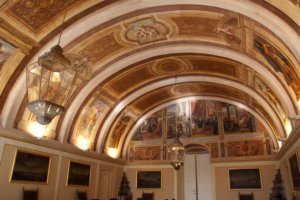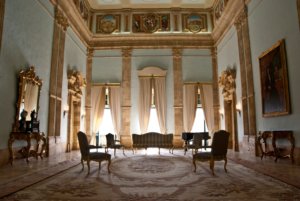Verdala Palace is perhaps one of the few palaces in Malta that still retains its original countryside setting. Set in the heart of the idyllic Buskett Gardens with breathtaking views of the island, it offered its past (and present) residents; currently it is the summer residence of the President of the Maltese Islands, a peaceful getaway from the noise and rush of everyday life, situated only ten minutes drive from Mdina.
The site itself started off at a hunting lodge built by Grand Master Jean de Valette during the late 1550s. Here he and other knights of the Order of St John, spent hours pursuing one of their favourite pastimes – game hunting. Some 30 years later this hunting lodge was turned into a palace by the then ruling Grand Master, Hugues Loubenx de Verdalle; the castle in fact still bears his name. The design of the palace was entrusted to Gerolamo Cassar, a local architect mainly renowned for the plan of many an important building in Valletta.
The palace, set on two floors, is rectangular in shape with additional five storey high towers on each corner. Adding highly defensible stance is a stone quarried ditch dug around its whole perimeter; part of the stones quarried away to form the ditch where used to construct the palace itself. Although the palace was never intended to act as a fort, its stoic appearance and imposing walls are a sign of the strength and military power associated with the Knights of Malta. Adjacent to the palace stand a chapel (mass is still occasionally celebrated here), stables and the servants quarters.

Verdala Palace main hall
The inside of the building is a jewel that testifies to the artistic prowess of many artists engaged by the various Grand Masters who inhabited the house following de Verdelle. Elements of baroque architecture, grand staircases, high, arched ceilings as well as ornate colourful frescoes decorate the ceilings. Of particular note is a fresco by none other than Palladini showing the many achievements of Grand Master de Verdalle.

Verdala palace piano nobile
During Malta’s brief and unruly 2 year stay within the hands of the French (1798-1800) the palace was used as a military prison for French soldiers unfortunate enough to fall in the hands of the rebellious Maltese.Once the French left the island the palace fell into disuse for some years. The palace started being paid attention to again during the British Rule in the mid 1800s once it started being used as a silk factory; it later was fully restored by Governor Sir William Reid in the 1850s. Following the restoration the palace became the official summer residence of the British Governors of Malta often welcoming illustrious guests such as the Empress of Russia (1909), the Emperor of Germany (1919) the King of England (1943).
During both World Wars the palace had important functions. During World War 1 it was used as a hospital whilst during World War 2 various works of art from Malta’s National Museum were safely kept here.
Once the British left the islands the palace became eventually the official summer residence of the President of Malta. Extensive restoration works were carried out in 1982. The newly restored magnificent palace also became the guest house of many a famous, and infamous, head of state visiting Malta. The latter also included Nicolae Ceausescu and Muammar Gaddafi. However, perhaps the most talked about resident of the palace is none other than the Blue Lady. The latter was the niece of Grand Master de Rohan, who following the marriage to a suitor not to her tastes, was imprisoned in her room in the palace. The unfortunate lady fell to her death whilst trying to escape the palace, and according to some, she can still be seen roaming the palace, in the same blue dress she was wearing when she fell to her death!